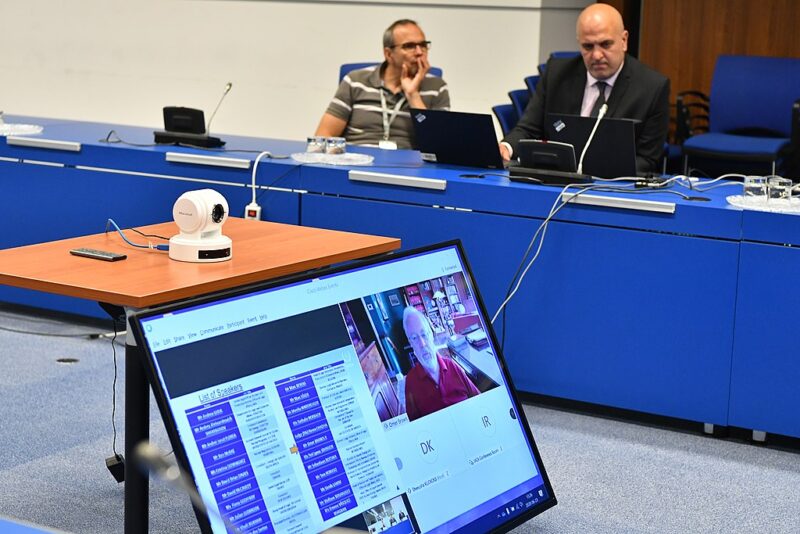
How To Host A Successful Virtual Event in 2025
Virtual events have gone from being a temporary solution to an integral part of the event industry.
COVID-19 pressed the accelerator on trends that were already unfolding: a worldwide remote work pilot, court virtualization, distance learning, and virtual conferences of all types and sizes.
Companies have grown, companies have gone under, but whatever happens, the age of virtual events is here to stay.
Continuing well into 2025, they will lead in how businesses, educators, and organizations connect with their target audience.
In our experience, compared to in-person events, the hosting of a virtual event can substantially save costs, reduce risks, and increase community inclusivity.
For the event organizers, virtual events offer new opportunities:
Yet, challenges such as audience engagement, technical glitches, and platform selection remain on top.
To succeed, organizers must embrace innovative tools, prioritize interactive experiences, and stay ahead of emerging trends like AI-powered event platforms and immersive VR environments.
For example, companies like HubSpot and Adobe have successfully hosted virtual events, leveraging gamification and live Q&A sessions to boost engagement.
Next-Level Advice: Virtual events are here to stay, offering cost efficiency, global reach, and flexibility. But to succeed, you’ll need the right tools and strategies. For example, AI-powered platforms and immersive VR environments are becoming game-changers. If you’re curious about the latest trends, check out the best AI tools for event planners. And if you’re planning a hybrid event, don’t miss this step-by-step guide to planning a hybrid event.
Mastering the Art of Virtual Events
As we move into 2025, the key to hosting a successful virtual event lies in understanding your audience, leveraging the right technology, and delivering value that rivals in-person experiences.
Time is a precious resource, so people will still be looking to save it and not fly halfway around the globe in order to present a poster at a conference.
Furthermore, virtual conferences enable more people from more diverse backgrounds to participate, a feature that can be expected to enhance a sense of horizontal collaboration.
Want to know what it takes to launch a successful virtual event in 2025? Let’s explore how to plan, execute, and optimize your next virtual event.
Choosing the Right Virtual Event Platform
Choosing the right virtual event platform is critical to your event’s success.
This typically includes user authentication and onboarding capabilities, the ability to manage intermissions, and a strong reporting functionality.
The ideal platform should also align with your event goals, audience size, and desired level of interactivity. Here’s why it matters:
It's a best practice to use a single platform to deliver scalability and reliability. So determine if the platform you choose can deliver both technology and administration all in one place.
Depending on the virtual event type, your platform would need to provide username lists, registration, and session attendance monitoring, integrated with video hosting and screensharing that allow for zero latency for thousands of concurrent attendees.
Your successful virtual event also depends on a promotion strategy that integrates with your chosen virtual platform.
Plugins like Modern Events Calendar and websites like Eventbrite allow you to schedule and promote virtual events effortlessly, send regular reminders to attendees and even handle booking.
Tip: Test the virtual event platform’s features and compatibility with your existing tools before committing. A trial run can help you identify potential issues and ensure a seamless experience.
By selecting the right virtual event platform, you can create a memorable, engaging experience that meets your audience’s expectations and drives your event’s success.
The main goal of a successful virtual event is to offer personalized communication, comfortable participation, and to strengthen learning and networking.
Cost-Saving Tip: Want to explore more options? Here’s a list of the best WordPress events calendar plugins. And if you’re new to WordPress, learn how to create an event website in 8 easy steps.
Create a Captivating Event Agenda
A well-structured agenda is the backbone of any successful virtual event. It keeps attendees engaged, ensures smooth transitions, and maximizes the value of their time.
In 2025, the digital world is full of amazing events and public figures, so it shouldn’t be difficult to have an impressive speaker lineup. A quick search on Youtube should be sufficient proof of this claim.
The snag comes when they all end up speaking about the same subject and hitting similar talking points.
An effective way to get around this is by informing your audience and speakers in advance and adding topics that are relevant and timely.
Without a clear plan, even the most exciting event runs the risk of disorganization.
Hopefully, with these strategies, you can create a stirring event agenda that will keep remote attendees engaged from start to finish.
You can craft an event schedule that’s sure to captivate your audience by breaking the event into manageable sessions.
It feels like we had a higher attention span before engaging with our screens for hours on end during the dreaded Covid lockdowns.
It used to be common for an audience to just sit and passively listen to speakers for hours, but now social media has trained us to crave something new and more engaging.
This is because attendees will only remain interested and complete a training program or a meeting in whole, or in part, if they are very aware of what they are going to get out of it.
Long, monotonous sessions can lead to attendee fatigue. Instead, divide your event into shorter, focused segments:
Here’s an example of such an agenda for a short virtual event where you can pick and choose what to include and exclude:
Without a doubt, one of the biggest challenges of virtual events is engaging the audience. One might think that the vibrancy of a physical event is not reproducible in a virtual event.
After all, who doesn’t miss those big industry events with several long walks in the traditional pavilions, all full of entertaining booths, stands, and companies eager to sell their products, with free bars, some music, and people running the old coffee corner.
To keep your audience hooked, experiment with dynamic formats to keep them engaged:
Due to the microlocalization interface of the Internet, it is possible to be present at several events at the same time without moving from the webcam or chair.
Tip: Use tools like Slido or Mentimeter to integrate interactive elements seamlessly into your virtual event.
According to Bizzabo, while in-person attendance reigns supreme with a strong 60%, around 35% percent of all events are happening virtually now and 5% are hybrid.
This means that a creative and captivating event agenda will not only maintain attendee interest but also deliver a successful virtual event that leaves a lasting impression.
Promote Your Virtual Event Effectively
Most people recognize the importance of promoting their event through the right channels. The problem is that most people aren’t really sure what these ‘right channels' are.
This is leaving so much engagement potential untapped.
A well-planned virtual event is only as successful as its promotion. Without a targeted marketing strategy, even the most compelling event can struggle to attract attendees.
Potential attendees will have some reservations to sign up for a virtual event from event quality to connection issues.
Therefore, hype is key, and the only way to deliver this is by selling the speakers, content, and freebies.
To drive sign-ups and build anticipation, you need a multi-channel approach that reaches your audience where they are.
Pro-Level Strategy: Promoting your event is just as important as planning it. From social media teasers to email campaigns, a multi-channel approach can drive sign-ups and build excitement. Need more ideas? Here are 10 budget-friendly event promotion hacks to fill your seats without big spending. And if you’re struggling with attendance, these proven tips to increase event attendance can help.
Here’s how to promote your virtual event effectively:
Develop a Targeted Marketing Strategy:
Start by identifying your target audience and tailoring your messaging to their interests and pain points. Use a mix of organic and paid tactics to maximize reach:
Engaging email campaigns are like spices in food. If they’re missing, the outcome doesn't give a very good feeling to anyone.
Leverage Event Management Tools:
An Event Management System serves as your event dashboard and manages registrations, integrates with your mail or CRM system, and provides invaluable insights and data pre and post-event.
Here are a couple of tools to streamline your event promotion:
Tip: Collaborate with speakers or influencers to amplify your reach. Their networks can help you tap into new audiences.
Build Anticipation with Engaging Content:
As mentioned before, hype is the name of the game and putting an emphasis on the caliber of speakers you’ve invited and the value gained from attending the event makes all the difference.
People have less access to speakers to ask questions and network with others so upselling the chance they have to ask questions or network with like-minded folks in virtual breakrooms is a good way to start.
By combining a targeted marketing strategy with the right tools and engaging content, you can drive sign-ups, build excitement, and ensure your virtual event is a resounding success.
Ensure Seamless Technical Setup
When your event gets underway, having a proper technical setup in place will ensure that things run smoothly.
Even the most engaging content can fall flat if attendees encounter glitches, poor audio, or connectivity issues. To deliver a smooth experience, thorough preparation and testing are essential.
Here’s how to ensure your technical setup will stick the landing:
Test Technology Before the Event :
Address Common Technical Challenges:
Conduct a “Dry Run” or Rehearsal
A rehearsal is crucial to iron out any kinks and ensure everyone is prepared:
Tip: Assign a dedicated technical support team to troubleshoot issues in real-time during the event. Even the best laid plans go awry, so be mentally prepared to take charge.
By prioritizing a seamless technical setup, you can minimize disruptions, enhance attendee satisfaction, and deliver a successful virtual event.
Foster Interaction and Engagement
When there is a large audience, it is vital to offer a sense of personalization, make sessions roomier, and go the extra mile to foster a feeling of community among the attendees.
It’s good to utilize the organic networks your attendees have by offering a tailor-made profile photo frame to announce their participation in your event and even a hashtag to share their thoughts and experience.
However, the virtual event space comes with its own challenges.
Without the energy of a physical venue, participants can quickly experience virtual fatigue, leading to drop-offs and reduced participation.
To combat this, it’s essential to design your event with interaction and engagement at its core.
One way to do this is by including features in them that would make them interact throughout the whole event.
For instance, live polls and surveys provide real-time feedback and tend to make attendees feel like active participants rather than passive viewers.
Live chat features allow attendees to share thoughts, ask questions, and connect with others, fostering a sense of community.
Virtual networking rooms, where participants can join smaller groups for discussions, replicate the informal interactions of in-person events and help build meaningful connections.
Gamification, such as quizzes, challenges, or leaderboards, can also add an element of fun and competition, keeping attendees motivated and involved.
Q&A sessions are a must, as they allow participants to interact directly with experts and get their questions answered in real time.
Breakout rooms are another powerful tool, enabling smaller, more focused discussions that encourage participation from those who might hesitate to speak in larger groups.
Ultimately, the success of your virtual event depends on how well you foster interaction. By prioritizing engagement and using the right tools, you can create an experience that feels personal, interactive, and memorable.
Event Success Tip: Engagement is the key to a successful virtual event. Features like live polls, Q&A sessions, and breakout rooms can make your event feel personal and interactive. Want to take it further? Discover how chatbots are transforming event planning in 2025 to boost engagement and streamline communication.
Measure Success and Gather Feedback
Measuring the success of a virtual event is the final step in figuring out what worked, what didn’t, and how you can improve next time.
By gathering data during and after the event, you can uncover insights that help you fine-tune your strategy and create even better experiences in the future.
Start by asking yourself key questions: Should this event happen again? What went well, and what fell short? These reflections will guide your planning for future events.
Start by tracking key performance indicators (KPIs) that align with your event goals.
Keeping an eye on such metrics can help event moderators who actively monitor chat and interact with attendees to boost audience satisfaction levels and engagement. For example:
Hopefully, your event met all success measures, but even if it didn’t, the valuable insights you’ve gained from attendee feedback can inform the planning of future events.
Post-event surveys play a critical role in gathering detailed feedback. Ask attendees about their experience, including what they enjoyed, what could be improved, and what topics or formats they’d like to see in future events.
This feedback is invaluable for tailoring your approach to meet your audience’s needs and preferences.
A virtual event platform is an immensely powerful data-driven tool, and while organizing any event is an art, it is also a science to know how to successfully incorporate data to enhance the experience for the attendees so that your event is a time to remember.
Engagement Maximizer: Measuring your event’s success is crucial for future improvements. Track KPIs like registration-to-attendee conversion rates and engagement levels to understand what worked and what didn’t. For a deeper dive into metrics, check out this guide on Event ROI KPIs for 2025. And don’t forget to engage attendees even after the event with these 5 smart strategies to keep them connected.”
Conclusion
Joining virtual events as a speaker or attendee is nothing like attending a traditional conference or exhibition. This is especially true after the pandemic has passed, and your virtual event must compete with a wider range of activities.
Hosting a successful virtual event in 2025 requires a blend of strategic planning, innovative thinking, and a commitment to delivering value to your audience.
From choosing the right platform and crafting a captivating agenda to fostering engagement and measuring success, each step plays a vital role in creating a memorable experience.
When it comes to the virtual space, ensure that you have a good team working with the platform.
Someone who is specialized in digital events should be the one managing and producing these events – preferably someone who is both efficient in event planning and in working with digital interfaces.
As the virtual event landscape continues to evolve, adaptability and ongoing learning are key.
What works today may need refinement tomorrow, so staying informed about emerging trends and technologies is essential.
Encourage your team to treat each event as an opportunity to experiment with new formats, tools, and strategies. Whether it’s integrating AI-powered features, exploring immersive virtual environments, or testing new interactive elements, innovation will set your events apart.
The future of virtual events is bright, and with the right mindset and tools, you’re well-equipped to lead the way.
Recommended Posts

How to Create an Effective Event Marketing Plan from Scratch in 2025
December 22, 2025






Nice